
|
|
Font Size:
|
||||
|
|
|
|
||||
STATISTICAL BRIEF #467:
Transitions in Health Insurance Coverage Over Time, 2012-2014 (Selected Intervals): Estimates for the U.S. Civilian Noninstitutionalized Adult Population under Age 65
Highlights
- Between the first part of 2013 and the first part of 2014, 30.2 percent of non-elderly adults who were uninsured gained coverage. This represents a higher rate of acquiring coverage than for similar time periods in 2012 and 2013 (24.6 percent).
- Overall, there was no significant decrease in the likelihood that insured adults lost coverage (5.5 percent between the first part of 2013 and the first part of 2014 and 6.0 percent for similar time periods in 2012 and 2013).
- Non-elderly adult Hispanics who had insurance in the first part of 2013 were less likely to lose coverage in 2014 than insured adult Hispanics in the previous period (8.8 percent in 2014 versus 12.1 percent in the 2012 to 2013 period). In addition, adult Hispanics who were uninsured in 2013 were more likely to gain insurance in 2014 (21.4 percent) compared to uninsured adult Hispanics in 2012 (15.8 percent).
- Non-elderly uninsured adults who were in good and less than good (fair or poor) health status in the first part of 2013 were substantially more likely to gain coverage in 2014 (28.6 percent for good and 28.9 percent for fair or poor health status) than their counterparts in the period from 2012 to 2013 (19.4 percent for those in good health and 20.9 percent for those in fair/poor health).
- Non-elderly adults uninsured in the first part of 2013 with 13 or more years of education were more likely to gain coverage in the first part of 2014 (36.5 percent) than their counterparts in the previous period (29.1 percent).
Introduction
Estimates of the health insurance status of the U.S. civilian noninstitutionalized population are critical to policymakers and others concerned with access to medical care and the cost and quality of that care. Health insurance helps people get timely access to medical care and protects them against the risk of expensive and unanticipated medical events. Studies of the changes in the health insurance coverage status of the population over time are often based upon cross-sectional information. To complement these investigations, it is important to understand the dynamics of the changes in coverage status for the same individuals over time.Using information from the Household Component of the Medical Expenditure Panel Survey (MEPS-HC) for the two-year intervals between 2012–2013 and 2013–2014, this Statistical Brief provides detailed estimates of health insurance coverage transitions for non-elderly adults between the ages of 18 to 64. More specifically, the health insurance coverage status for the adult population under age 65 in the first part of 2013 and 2014 is examined, conditioned on the health insurance coverage status for the comparable period in the previous year. Survey participants were asked whether they had coverage at some point between January 1 and the date of the MEPS interview; individuals classified as being uninsured had no health insurance coverage, as defined in MEPS, for the entire time between January 1 and the date of the interview, while people who were classified as insured had coverage for at least some period of time during this interval. In 2014, MEPS interviews took place from January through June, with the majority of the interviews completed in the first three months of the year, which was prior to the end of the Marketplace open enrollment period. The health insurance estimates in this Statistical Brief therefore reflect some, but not all, of the increases in coverage obtained through the Affordable Care Act's Health Insurance Marketplaces. All differences between estimates discussed in the text are statistically significant at the 0.05 level unless otherwise noted.
Findings
According to the MEPS-HC, 30.2 percent of non-elderly adults who were uninsured for the first part of 2013 gained insurance in the first part of 2014. This represents a higher percentage of non-elderly uninsured adults gaining coverage than in the period between 2012 and 2013 (24.6 percent). Substantial gains in coverage were noted across a broad array of population subgroups defined by age, sex, race/ethnicity, education, health status, and state Medicaid expansion status. Overall, there was no significant decrease in the likelihood that insured adults lost coverage (5.5 percent between the first part of 2013 and the first part of 2014 and 6.0 percent for similar time periods in 2012 and 2013) (figure 1).Adults ages 25–44 and 45–63 who were uninsured in the first part of 2013 were more likely to gain coverage in the subsequent year than those in the previous time period. Among those uninsured in 2013, 28.6 percent of uninsured adults ages 25–44 gained insurance in the first part of 2014 compared to 23.9 percent in the 2012 to 2013 period. For adults ages 45–63, 30.2 percent gained insurance in the first part of 2014 compared with 22.4 percent in the previous time period (figure 2).
Non-elderly adult women uninsured in the first part of 2013 were more likely to gain insurance in 2014 (33.9 percent) than non-elderly men (27.1 percent). Both non-elderly uninsured adult women and men were more likely to gain insurance in the 2013–2014 period than in the 2012–2013 period (33.9 percent versus 28.7 percent for women and 27.1 percent versus 21.1 percent for men) (figure 3).
Non-elderly adults uninsured in the first part of 2013 with 13 or more years of education were more likely to gain coverage in 2014 (36.5 percent) than uninsured adults with similar education in the previous period (29.1 percent). They were also more likely to gain coverage in 2014 than non-elderly adults with less than 12 years of education (21.3 percent) and with 12 years of education (28.4 percent) (figure 5).
Non-elderly uninsured adults who were in good and less than good (fair or poor) health status in the first part of 2013 were more likely to gain coverage in the following year than their counterparts in the previous period (28.6 percent versus 19.4 percent for those in good health and 28.9 percent versus 20.9 percent for those in fair/poor health) (figure 6).
Insured non-elderly adults in 2013 living in states that participated in the 2014 Medicaid expansion were less likely to lose coverage in 2014 (4.5 percent) than they were in the period from 2012 to 2013 (5.9 percent). They were also less likely to lose coverage in 2014 than insured non-elderly adults living in states that did not participate in the Medicaid expansion (6.8 percent).
Regardless of whether their state participated in the Medicaid expansion in 2014, non-elderly adults that were uninsured in 2013 were more likely to gain insurance in 2014 than their counterparts in the period from 2012 to 2013 (32.9 percent versus 26.9 percent in states that expanded Medicaid and 27.9 percent versus 21.6 percent in states that did not expand Medicaid) (figure 7).
Data Source
The estimates shown in this Statistical Brief are drawn from analyses conducted by the MEPS staff from the following public use files: HC-143 and HC-151 for the 2012 to 2013 analysis and a preliminary analytic file for the 2013 to 2014 data. This preliminary file can be accessed in the CFACT Data Center.Definitions
First part of year reference period The reference period for the first interview during a year spans from January 1 through the date of interview and ranges from about 1 to 6 months.Uninsured People who did not have coverage during the period from January of the survey year through the time of their first interview in that year were classified as uninsured during the first part of the year. Interviews were typically conducted from February to June. The uninsured were defined as people not covered by Medicare, TRICARE (Armed Forces-related coverage), Medicaid, other public hospital/physician programs, or private hospital/physician insurance (including Medigap coverage). People covered only by non-comprehensive State-specific programs (e.g., Maryland Kidney Disease Program) or private single service plans such as coverage for dental or vision care only, or coverage for accidents or specific diseases, were considered uninsured.
Insured People who had coverage at any point during the period from January of the survey year through the time of their first interview in that year were classified as insured during the first part of the year. Interviews were typically conducted from February to June. The insured were defined as people covered by Medicare, TRICARE (Armed Forces-related coverage), Medicaid, other public hospital/physician programs, or private hospital/physician insurance (including Medigap coverage). People covered only by non-comprehensive State-specific programs (e.g., Maryland Kidney Disease Program) or private single service plans such as coverage for dental or vision care only, or coverage for accidents or specific diseases, were not considered to be insured.
Population covered Persons included in this analysis were present for the entire two-year reference period, first part of 2012–first part of 2013: first part of 2013–first part of 2014.
Age Age was defined as the person's age at the time of the Round 1 interview in the first year of the two-year period and at the time of the Round 3 interview in the second year. In figure 2, individuals are classified by their age at the time of the Round 1 interview. Individuals are included in the analysis if they were ages 18–63 in the first year and ages 18–64 in the second year.
Race/ethnicity Classification by race/ethnicity was based on information reported for each family member. Respondents were asked if each family member's race was best described as American Indian, Alaska Native, Asian or Pacific Islander, black, white, or other. They also were asked if each family member's main national origin or ancestry was Puerto Rican; Cuban; Mexican, Mexicano, Mexican American, or Chicano; other Latin American; or other Spanish. All persons whose main national origin or ancestry was reported in one of these Hispanic groups, regardless of racial background, were classified as Hispanic. Since the Hispanic grouping can include black Hispanic, white Hispanic, Asian and Pacific Islander Hispanic, and other Hispanic, the race categories of black, white, Asian and Pacific Islander, and other do not include Hispanic. MEPS respondents who reported other single or multiple races and were non-Hispanic were included in the other category. For this analysis, the following classification by race and ethnicity was used: Hispanic (of any race), non-Hispanic blacks, non-Hispanic whites, and non-Hispanic others.
Education Education was defined as years of school completed as of the first part of 2012 and as of the first part of 2013.
Health status In every round, the respondent was asked the following question to rate the health of every member of the family: "In general, compared to other people of (PERSON)'s age, would you say that (PERSON)'s health is excellent, very good, good, fair, or poor?" Health status was based on the first round of the 2012 interview and the first round of the 2013 interview. For this Brief, the response categories "fair" and "poor" were collapsed.
Medicaid expansion/non-expansion state Classification into Medicaid expansion or non-expansion states was based on state of residence in the second year of the time period. We excluded individuals living in NH and MI since their Medicaid expansion status changed in 2014. Of the remaining states, the following states were classified as Medicaid expansion states: AZ, AR, CA, CO, CT, DE, DC, HI, IA, IL, KY, MD, MA, MN, NV, NJ, NM, NY, ND, OH, OR, RI, VT, WA, WV. All others are considered non-Medicaid expansion states.
About MEPS-HC
MEPS-HC is a nationally representative longitudinal survey that collects detailed information on health care utilization and expenditures, health insurance, and health status, as well as a wide variety of social, demographic, and economic characteristics for the U.S. civilian noninstitutionalized population. It is cosponsored by the Agency for Healthcare Research and Quality and the National Center for Health Statistics.For more information about MEPS, call the MEPS information coordinator at AHRQ (301-427-1406) or visit the MEPS Web site at http://www.meps.ahrq.gov/.
References
For a detailed description of the MEPS-HC survey design, sample design, and methods used to minimize sources of nonsampling error, see the following publications:Carroll, W. The Uninsured in America, First Part of 2013: Estimates for the U.S. Civilian Noninstitutionalized Population under Age 65. Statistical Brief #447. August 2013. Agency for Healthcare Research and Quality, Rockville, MD. http://www.meps.ahrq.gov/mepsweb/data_files/publications/st447/stat447.shtml
Cohen, J. Design and Methods of the Medical Expenditure Panel Survey Household Component. MEPS Methodology Report No. 1. AHCPR Pub. No. 97-0026. Rockville, MD: Agency for Health Care Policy and Research, 1997. http://www.meps.ahrq.gov/mepsweb/data_files/publications/mr1/mr1.shtml
Cohen, S. Sample Design of the 1996 Medical Expenditure Panel Survey Household Component. MEPS Methodology Report No. 2. AHCPR Pub. No. 97-0027. Rockville, MD: Agency for Health Care Policy and Research, 1997. http://www.meps.ahrq.gov/mepsweb/data_files/publications/mr2/mr2.shtml
Cohen, S. Design Strategies and Innovations in the Medical Expenditure Panel Survey. Medical Care, July 2003: 41(7) Supplement: III-5–III-12.
Cohen, S. Transitions in Health Insurance Coverage Over Time, 2009–2013 (Selected Intervals): Estimates for the U.S. Civilian Noninstitutionalized Adult Population under Age 65. Statistical Brief #439. May 2014. Agency for Healthcare Research and Quality, Rockville, MD. http://www.meps.ahrq.gov/mepsweb/data_files/publications/st439/stat439.shtml
Ezzati-Rice, T.M., Rohde, F., Greenblatt, J. Sample Design of the Medical Expenditure Panel Survey Household Component, 1998–2007. Methodology Report No. 22. March 2008. Agency for Healthcare Research and Quality, Rockville, MD. http://www.meps.ahrq.gov/mepsweb/data_files/publications/mr22/mr22.shtml
Rhoades, J.A. and Cohen, S.B. The Long-Term Uninsured in America, 2008–2011 (Selected Intervals): Estimates for the U.S. Civilian Noninstitutionalized Population under Age 65. Statistical Brief #424. November 2013. Agency for Healthcare Research and Quality, Rockville, MD. http://www.meps.ahrq.gov/mepsweb/data_files/publications/st424/stat424.shtml
Roemer, M. The Uninsured in America, First Part of 2012: Estimates for the U.S. Civilian Noninstitutionalized Population under Age 65. Statistical Brief #422. September 2013. Agency for Healthcare Research and Quality, Rockville, MD. http://www.meps.ahrq.gov/mepsweb/data_files/publications/st422/stat422.shtml
Suggested Citation
Vistnes, J. and Cohen, S. Transitions in Health Insurance Coverage Over Time, 2012–2014 (Selected Intervals): Estimates for the U.S. Civilian Noninstitutionalized Adult Population under Age 65. Statistical Brief #467. February 2015. Agency for Healthcare Research and Quality, Rockville, MD. http://www.meps.ahrq.gov/mepsweb/data_files/publications/st467/stat467.shtmlAHRQ welcomes questions and comments from readers of this publication who are interested in obtaining more information about access, cost, use, financing, and quality of health care in the United States. We also invite you to tell us how you are using this Statistical Brief and other MEPS data and tools and to share suggestions on how MEPS products might be enhanced to further meet your needs. Please email us at MEPSProjectDirector@ahrq.hhs.gov or send a letter to the address below:
Steven B. Cohen, PhD, Director
Center for Financing, Access, and Cost Trends
Agency for Healthcare Research and Quality
540 Gaither Road
Rockville, MD 20850
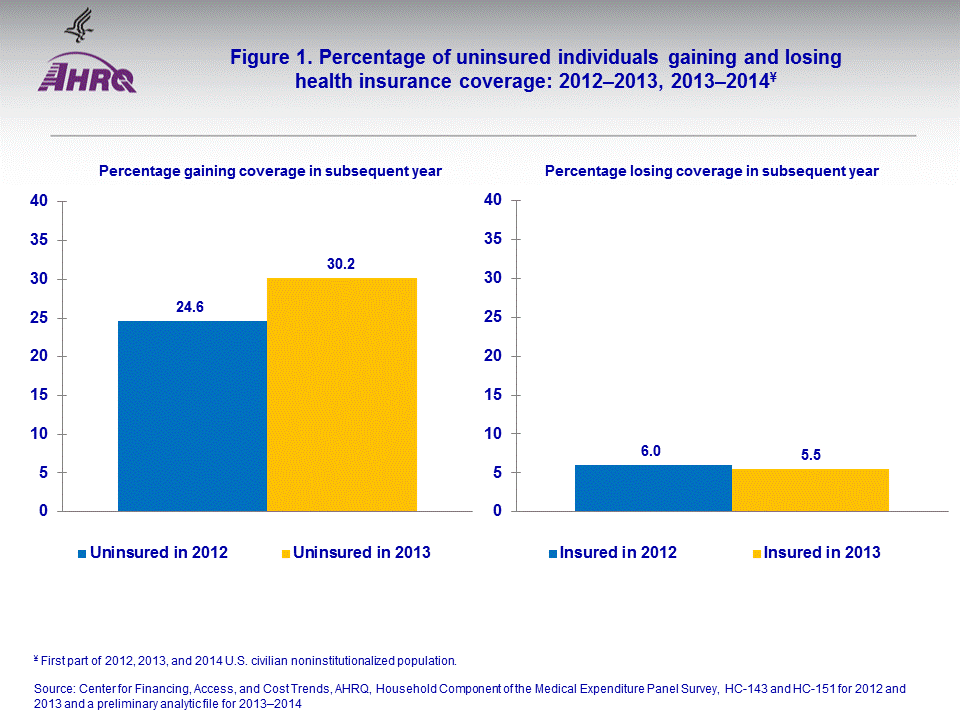 |
||||||||||||||||||||||||||||||
|
||||||||||||||||||||||||||||||
|
|
||||||||||||||||||||||||||||||
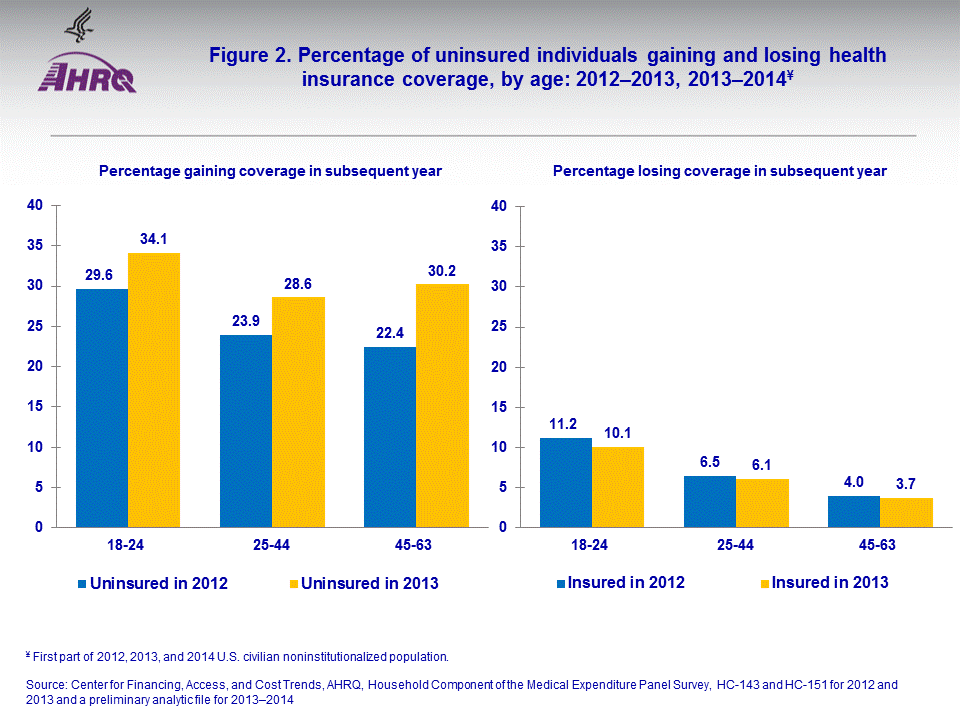 |
||||||||||||||||||||||||||||||
|
||||||||||||||||||||||||||||||
|
|
||||||||||||||||||||||||||||||
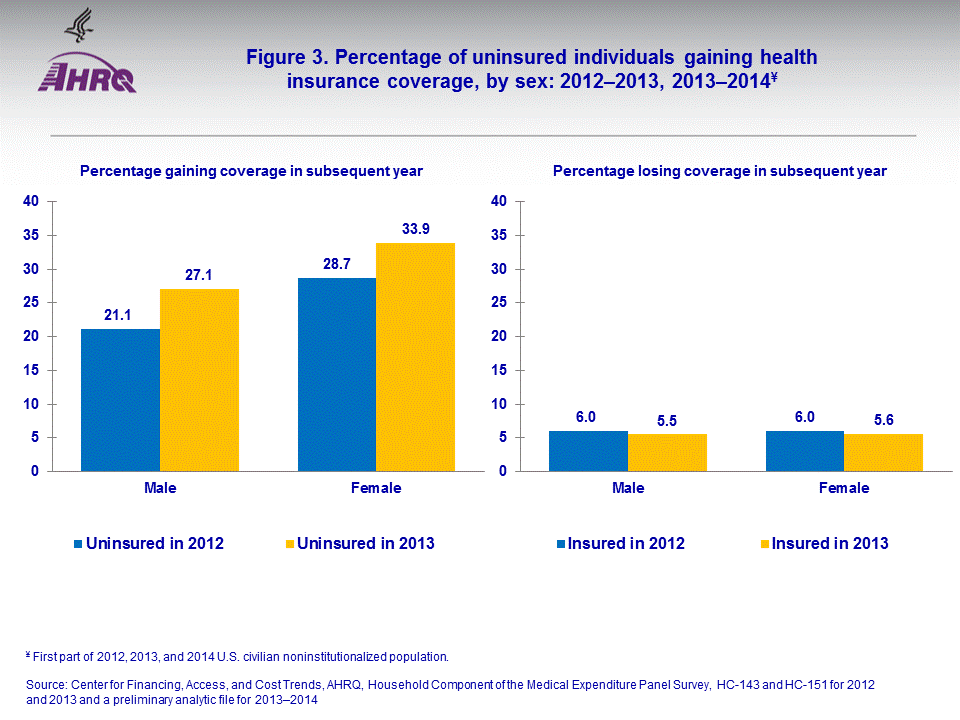 |
||||||||||||||||||||||||||||||
|
||||||||||||||||||||||||||||||
|
|
||||||||||||||||||||||||||||||
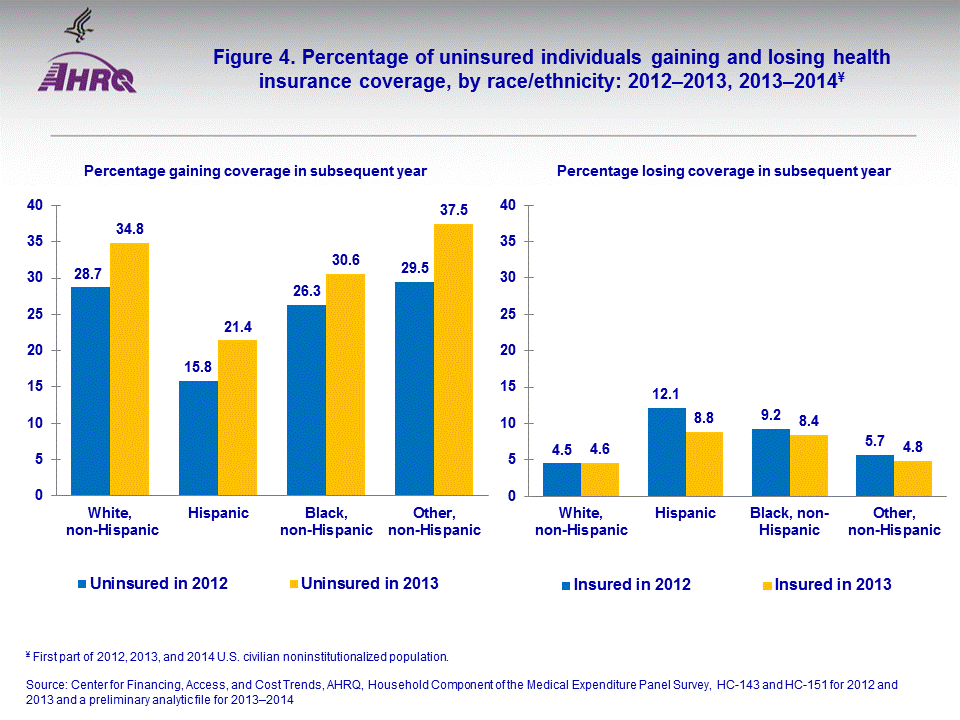 |
||||||||||||||||||||||||||||||
|
||||||||||||||||||||||||||||||
|
|
||||||||||||||||||||||||||||||
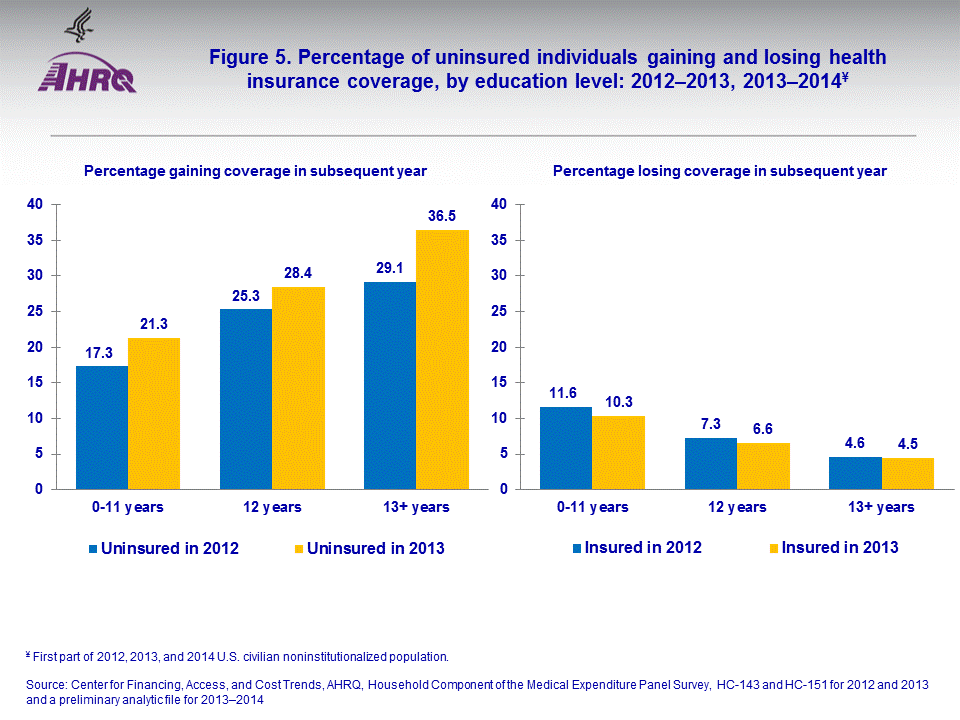 |
||||||||||||||||||||||||||||||
|
||||||||||||||||||||||||||||||
|
|
||||||||||||||||||||||||||||||
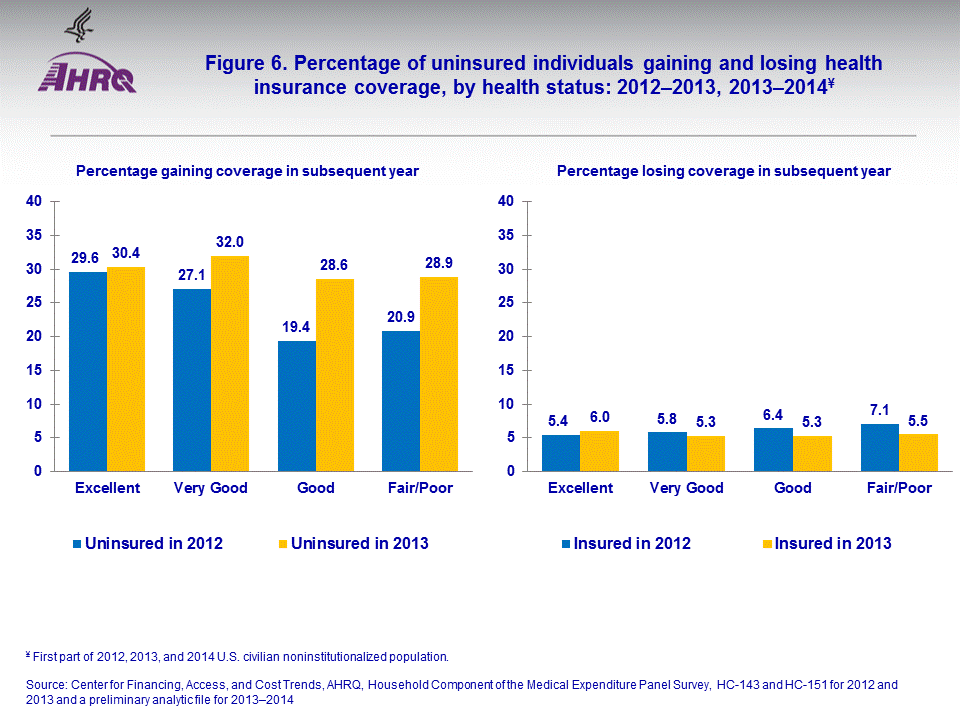 |
||||||||||||||||||||||||||||||
|
||||||||||||||||||||||||||||||
|
|
||||||||||||||||||||||||||||||
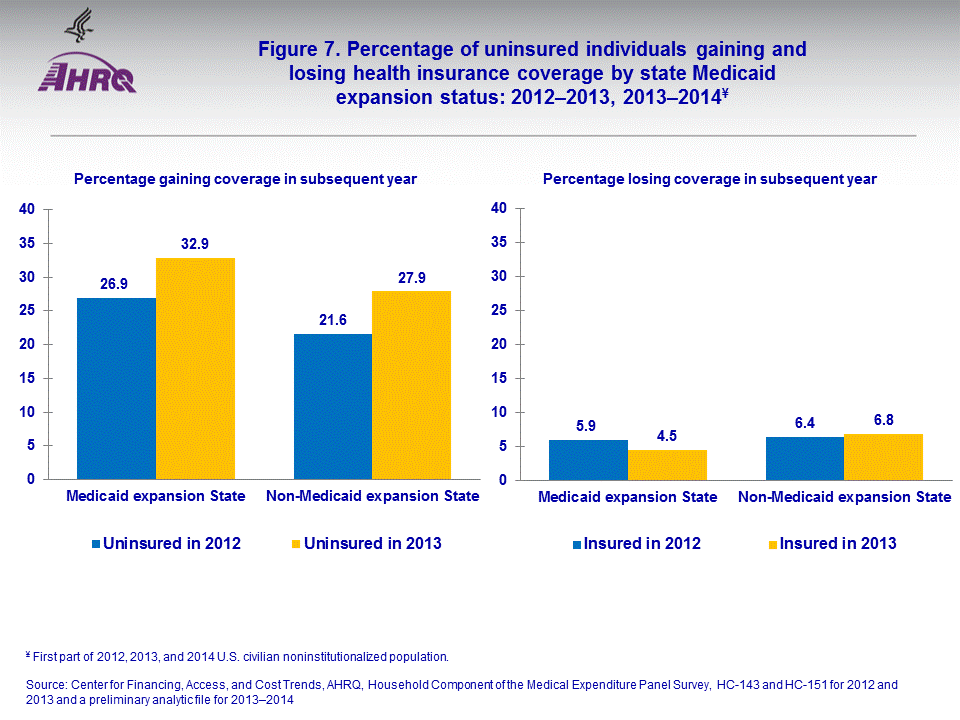 |
||||||||||||||||||||||||||||||
|
||||||||||||||||||||||||||||||
|
|
||||||||||||||||||||||||||||||


